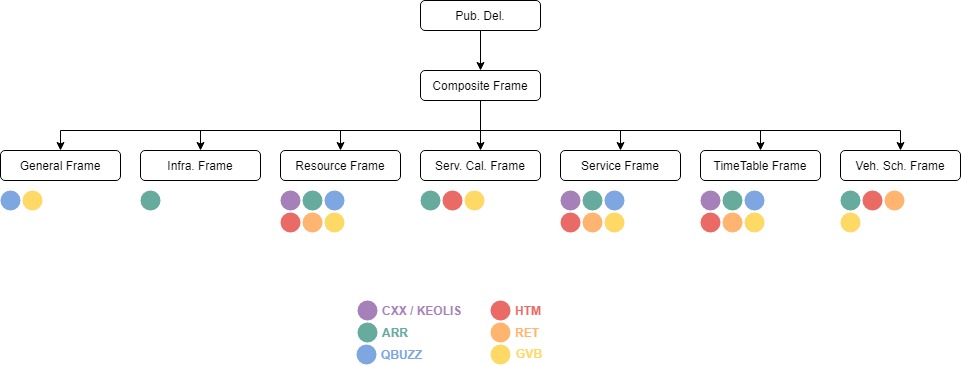To NeTEx or not to NeTEx?
VANL has been processing Public Transport timetables for years. As of the first of August, we have switched to the new NeTEx format. This blog is about our considerations and wonders.
The following criteria were important:
- Is the quality of the new timetables just as good as the current files?
- Can we link it to overarching master data such as concessions and the central stop file?
- Can we process the files in a simple way?
- What other changes did operators make during the transition to NeTEx?
- What does the transition process look like?
Are they the same files?
The Dutch public transport is now in a dual period. Timetables are published in both KV1 and in NeTEx. This offers data processing companies the opportunity to test and choose their own moment for the switch. Both of the public transport data providers offer the new NeTEx files and still offer KV1 files. The method for accessing said files is not the same at these providers. Therefore, we have a clear preference.
If you expect that there is a NeTEx file for every KV1 file, you will be disappointed. It is true that there are operators that convert a KV1 file into a NeTEx file with the same content, but our conclusion is that the files cannot easily be compared. Delivery frequency and scope sometimes differ considerably. For example, Connexxion has gone from about five KV1 files to about 800 NeTEx files per month, and separate changes are published for each region and sometimes even per line. While GVB is making the opposite move, first with KV1 deltas and now one NeTEx for the whole of GVB.
The same NeTEx then?
Actually, no. Yes, all available files comply with the NeTEx standard, but carriers give their own interpretation to that standard. In addition, multiple versions of the NeTEx standard are in circulation because PT companies have adopted it earlier or later. As a data processing company you still have to build specific interpretations for each PT company. For example, how to deal with points at which the transit time is measured. These are usually stops, but especially at non-public time measurement points, such as bridges, traffic lights or concession boundaries, there are differences. One operator removes them from NeTEx and another puts in extra points.

The picture above gives an impression of the implementation by different operators. How to compare them?
All data then?
It remains difficult to check whether you have all the timetables. Unfortunately, even in the NeTEx era, our data stewards have to keep checking daily if new lines are being added and then search the internet for the underlying contract. There is a central concession file, but it is managed in the same way; reactively.
KV1-NeTEx status dashboard
DOVA asked us to set up a dashboard that provides insight into the extent to which operators are ready for NeTEx. This gave us the opportunity to dive deep into the NeTEx data and compare it with the current KV1 data at all levels.
We have defined the following key figures as cricitcal, which need to be equal in both short term plannings; the number of journeys, the distance and duration of the journeys and the number of stops. To locate the differences, the dashboard can be zoomed in to line-day level.
Differences have been traced back to the source file and explained. Where the NeTEx outcome is useful, a comment has been placed and the quantities have been approved.
The KV1-NeTEx dashboard is available under ovcontext.nl. Please contact us or DOVA if you want access to the dashboard or if you are interested in the extensive test report.
Our conclusion
Because we are involved in transport analyses at VANL, aspects such as passenger information and fares play a subordinate role. It is important to us whether the routes, bus journeys and stops in NeTEx files are the same as the current KV1 files.
Now that all city and regional operators deliver NeTEx of usable quality, the transition from KV1 to NeTEx was possible for us. As a data processing company, you will have to test each operator seperatly. We are done with this and have turned the switch. We will continue to test and compare with KV1 for a period, in order to be able to go back when of if necessary.
It is a pity that the transition has been seized by some operators to implement other changes. In their eyes, these are certainly improvements, but it does not help the data processing companies if several things have changed at the same time. We had to adjust a few extra things in our processing line.
Our tip and invitation
NeTEx files are XML files. The eXtractorONE tool was a life-saver for us to handle the variable structure towards a staging database that is a good source for further processing. Buy the tool yourself, take advantage of our special combined offer of just come and have a coffee. We are happy to help other data processing companies on their way with NeTEx.


0 Comments